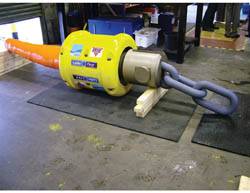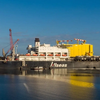Structural Integrity NDT Test for Deepwater Fiber Rope Connectors
First Subsea is using innovative non-destructive testing (NDT) technology to inspect the quality of forgings used in the new range of LankoFirst fiber rope connectors for deepwater moorings.
Process Compensated Resonance Testing (PCRT) undertaken by Vibrant NDT Ltd is reportedly the only NDT technology to correlate to the structural integrity of the inspected component.
The LankoFirst fiber rope mooring connector is designed to revolutionize the ease with which deepwater fiber mooring lines for rope-rope, rope-wire and rope-chain connections are deployed offshore. Developed specifically for deepwater fiber connections, the connectors are smaller, lighter, stronger and more efficient than current plate links and thimbles for the same MBL.
Ease of make-up offshore is enabled by splicing the Lankofirst's sub-connector to the rope end during rope manufacture. It is this donut-shaped subconnector that is being tested using PCRT.
Briefly, during PCRT the subconnector is excited with minute, through thickness vibrations generated by dry coupled piezoceramic transducers, from a continuous swept sine frequency input. The resonant spectra of the excited components is then logged permanently in a digital library and compared to spectras from known good and defective sub-connectors.
PCRT measures the variations in resonance signatures that are the result of variations in structural integrity. In this way the PCRT software "learns" the acceptable manufacturing variations as well as the unacceptable variations caused by material problems, process problems, and in-process damage.
Resonance Test 'Fingerprint'
In addition the PCRT technique can be used to compare a component's resonance signature before use, during (as part of an inspection routine) and after use, and thus monitor the connector's structural intergrity for the onset of fatigue before cracking has begun.
“The PCRT technique gives us a method of assessing the structural integrity of deepwater fiber rope mooring connectors that simply hasn't existed until now. For the first time operators and installers are able to specify levels of structural intergrity in mooring line connectors that reflect the demands of long-term, deepwater mooring,” said Brian Green, general manager, First Subsea Ltd.












